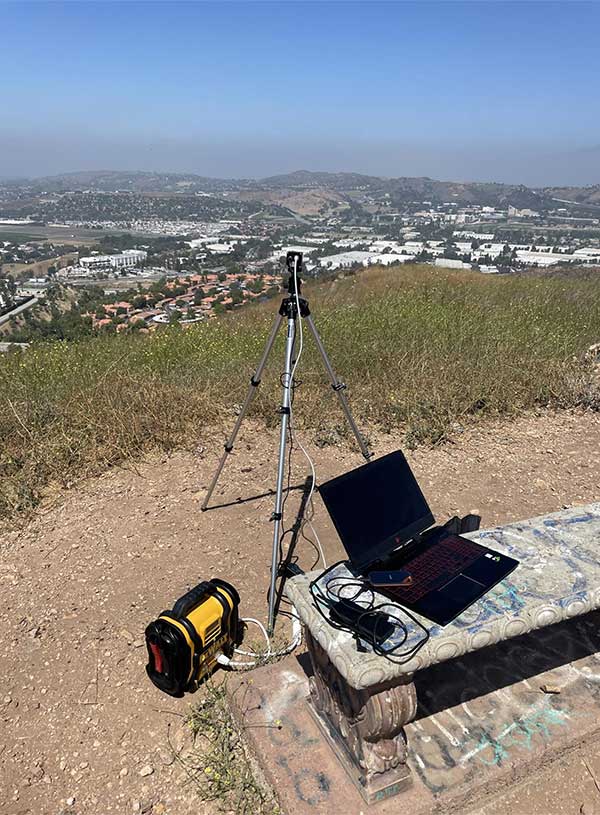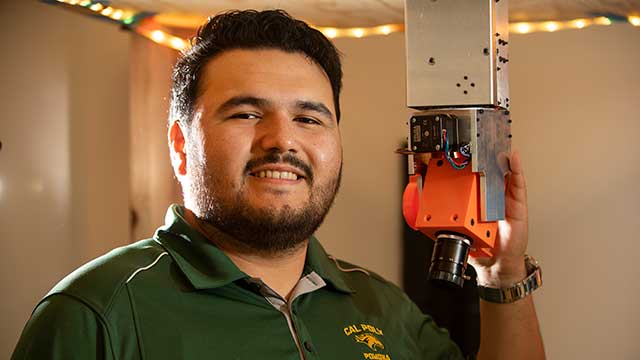Bronco Ember, a miniature satellite designed by students to detect nascent wildfires, passed its final inspection in the NASA TechLeap Challenge and is scheduled for a suborbital flight test at the end of June. The team has also earned $500,000 over the course of the competition.
The Bronco Space club team was one of just three groups selected to advance in the competition, which "focused on the advancement of integrated, compact precision pointing systems for small spacecraft that can be used to autonomously detect, locate, track, and collect data on transient terrestrial events."
The students developed their CubeSat and its mission last summer under the orange skies of one of California's worst wildfire seasons. Designed to be part of a network, Bronco Ember will scan for small wildfires, record the coordinates and send those coordinates to first responders giving them the opportunity to respond before the fires burn thousands of acres.
After advancing, the team had eight months to show NASA a proof of concept and just 10 months to finish their satellite. Bronco Ember weighs about three pounds and consists of a camera, a custom 2DOF precision pointing system and edge computing system for onboard artificial intelligence and advanced machine learning, all of which must fit into a compact container the size of a very slim shoe box.
"Early on, we focused on what we could build to show NASA some progress by the first review," said Cristian Rodriguez ('22, master's in mechanical engineering), who is the student principal investigator. "We wanted to show them how we would control the camera, get our data on altitude and what a fire looks like in our optics…. What we really needed to do was figure out was what was possible with our camera, and how we would determine what a fire even looks like from that distance."
With supply chain issues in the initial phase, students began creating their own custom parts, testing and refining. Even with easing supply chains, about 40 percent of Bronco Ember's parts are student-made.
A bigger hurdle was finding a dataset to train the Ember's artificial intelligence to recognize a fire. The team is imaging in shortwave infrared, which will give Bronco Ember the advantage of being able to see through smoke and clouds, but infrared images from space in that wavelength were not publicly available.
"What that forced us to do is to figure out ways to simulate images from space without going to space," explained Zachary Gaines, a senior majoring in aerospace engineering and the project manager. "We had a lot of skill testing, climbing mountains, going to beaches, making small fires, and scaling light sources - all to curate an environment similar to what we will see from altitude."
 Test of the Bronco Ember camera and wildfire detection AI looking towards campus from a hill in Diamond Bar.
Test of the Bronco Ember camera and wildfire detection AI looking towards campus from a hill in Diamond Bar.In May, the team set up a campfire in the overflow parking lot and Gaines, who was on a hill 1.5 miles away, turned on the camera.
"There was this tiny little campfire glowing bright on my screen," said Gaines. "It was so obvious where it was. I was looking at the same spot with my eyes, and I saw nothing, but my camera was just lighting up. That was the moment when I realized that what we're doing is really possible, and what this imaging technology can do is really powerful."
Bronco Ember is scheduled to launch the week of June 27 on a Raven Aerostar high altitude balloon that will float up to approximately 18.5 miles above Earth for about eight hours. Tracking the balloon, the Cal Poly Pomona team will drive to different sites, light fires in fire pits, wait for the satellite to detect the fires and send them a message with the coordinates.
With their work on Ember, the students are gaining hands-on experience in a leading edge of space technology. The dramatically lower cost of CubeSats and their shorter development time compared to traditional satellites "is opening up space exploration like never before," according to JPL. CubeSat technology is cited as a driver for miniaturization of systems and a new approach to packaging and integration as well as widening opportunities for space-based research beyond governments and the aerospace industry.
"Small satellite technology is really revolutionizing the industry," said Gaines. "People are realizing they can get the same performance or better in smaller and dramatically less expensive satellites."
In the case of Bronco Ember, there are fewer sensors and a smaller field of view than a traditional observation satellite, but a Bronco Ember network would be able to provide more consistent monitoring of an area for wildfire with its short-wave infrared imaging for a much lower total cost.
Gaines, who also worked on BroncoSat-1, which launched in May, came to Cal Poly Pomona for its strong engineering program but didn't expect the opportunities he's had.
"It's crazy to know that as a [student], I have a satellite orbiting overhead, reflected Gaines. "I'm a senior and getting support from NASA to do things I want to do. That's the most enabling thing about Bronco Space. We really encourage people to do the things they love to do…. We have a new lab space that anyone in the club can use, and Bronco Ember has brought in more funding for different projects allowing students to work on really cool space technology."
Members of the Bronco Ember team include:
- PI: Cristian Rodriguez
- Project Manager: Zachary Gaines
- Controls team: Julian Garcia (lead), Enrique Navas and Michael Quach
- Mechanisms: Scott Johnson (lead), Chase Pelliterri (co-lead), Jonathan Camilleri, Nick Shewchuk, Federico Perez and Juan Carlos Macias
- Electronics: Tyler Boardman (lead) and Derek Mata
- Software: Max Wilder Smith (lead), Thang Nguyen (co-lead) and Clayton Clark
- Systems: Katie Ruiz (lead), Ethan Lo, Joshua Cepeda, Tyler Kovacs and Granville Goza
- Integration and Testing: Jacqueline Llamas (lead) and Matthew McDougall
The Bronco Space advisor is Tarek Elsharhawy, a lecturer in aerospace, electrical and mechanical engineering and a 1995 Cal Poly Pomona alumnus.


